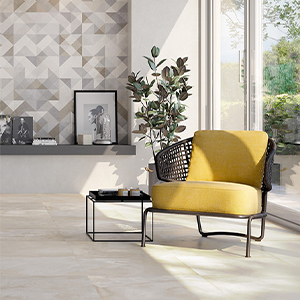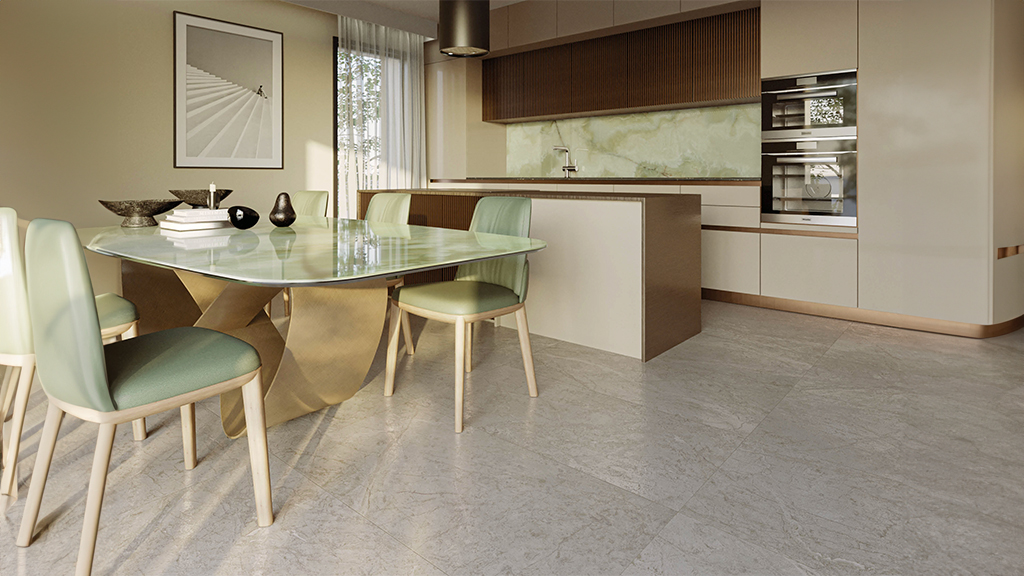Index
- Introduction
- Why it is important to choose non-slip flooring
- What is non-slip flooring?
- Non-slip standards and classifications (R9-R13)
- Non-slip ceramic materials
- How to choose the right material
- Anti-slip technologies and treatments
- Maintenance and cleaning
- Specific applications
- Design and safety: you can have both
- Why choose Sicer surfaces
- FAQ
- Conclusions
Introduction
When it comes to safety in indoor and outdoor environments, choosing non-slip flooring is crucial. Whether it’s a private home, a restaurant, or an industrial space, reducing the risk of falls is a priority. In this guide, you’ll find out everything you need to know to choose the most suitable non-slip tiles, with a particular focus on ceramic materials.
Why it is important to choose non-slip flooring

Falls on walking surfaces are one of the leading causes of accidents. Investing in safe flooring is not just a matter of aesthetics, but also of responsibility. For high-humidity environments, such as bathrooms, kitchens, or outdoor areas, non-slip ceramic tiles are the most reliable solution.
What is non-slip flooring?

A non-slip surface is designed to increase friction when in contact with the foot, even in the presence of water or oils. This is achieved through:
- Specific surface structures
- High-grip materials
- Chemical or abrasive treatments
Technical definition: according to DIN 51130, slip resistance is classified based on inclined tests, determining values from R9 to R13.
Anti-slip standards and classifications (R9-R13)
According to UNI regulations and German standard DIN 51130, slip resistance is classified based on inclined tests.
Here is an explanatory table of the R levels, useful for understanding where and when to use certain floors:
| Class R | Angle of inclination | Adhesion | Recommended applications |
| R9 | 6°-10° | Low | Private indoor environments |
| R10 | 10°-19° | Medium | Kitchens, corridors |
| R11 | 19°-27° | High | Public bathrooms, schools |
| R12 | 27°-35° | Very high | Workshops, production areas |
| R13 | >35° | Extrem | Heavy industry |
Non-slip ceramic materials
Ceramic is the queen of flooring in terms of resistance, aesthetics, and safety. Here are the most commonly used materials:
Non-slip porcelain gres
Among the most versatile: resistant, compact, waterproof. The textured R11 and R12 versions are perfect for outdoor and wet environments.
Glazed ceramic
Offers a wide variety of styles. Thanks to technical glazes, it can achieve levels of R10 or higher, with excellent aesthetic results.
Terracotta
Traditional and warm, ideal for rustic environments. It must be treated to improve grip.
Clinker
Ideal for industrial or high-wear environments. Very compact and durable, it easily achieves classes R12 and R13.
How to choose the right material

The choice of non-slip flooring depends on many factors that go beyond aesthetics. To make a correct assessment, it is essential to consider the context of use, the expected level of traffic, and the environmental conditions. The following chart visually summarizes the main elements to keep in mind when making your decision:
Anti-slip technologies and treatments
Today, research has led to innovations that improve anti-slip properties without compromising aesthetics:
Textured surfaces
The texture of the material itself creates micro-roughness that improves friction.
Chemical treatments
Products applied to the surface that modify the properties of the material.
Abrasive inserts
Used in industrial areas or on stairways, they significantly increase grip.
Maintenance and cleaning
Regular maintenance is essential to maintain anti-slip properties. Some tips:
- Use non-waxing detergents
- Avoid oil-based products
- Use pressure washers or outdoor brushes
Tip: Sicer offers easy-to-clean surfaces that maintain their anti-slip properties even after years of use.
Specific applications

Bathrooms and wet areas
R11 or higher surfaces are perfect, with neutral designs or a stone effect.
Kitchens
Stain- and grease-resistant materials, preferably in non-slip porcelain gres.
Outdoor areas
It is best to opt for R12 or R13 surfaces, which are resistant to frost and temperature changes.
Commercial and industrial environments
Mechanical resistance and high grip are required. Klinker or textured stoneware are ideal.
Design and safety: you can have both
Nowadays, it is no longer necessary to choose between beauty and safety. Digital technologies and 3D printing on ceramic allow you to achieve:
- Wood, stone, and concrete effects
- Refined textures
- Continuous surfaces with no visible joints
Why choose Sicer surfaces
Sicer is an Italian company operating internationally in the production of innovative materials for ceramic decoration, with a strong focus on research and development of advanced technical solutions. Its specializations include: grits, digital inks, frits, and surface technologies designed to combine performance, aesthetics, and sustainability.
The choice of ceramic material has a decisive impact on the slip resistance of a surface, especially in contexts where safety, aesthetics, and durability must coexist.
This is where NEXT Surfaces comes in, a technology developed by Sicer that allows for natural, slip-resistant surfaces from R9 to R11 that are velvety to the touch, while maintaining high technical performance.
Ideal for high-traffic residential and commercial environments, this treatment stands out for its ability to combine comfort and safety.
Find out more about NEXT surfaces→
FAQ
They are surfaces designed to provide greater friction in wet or damp conditions, such as textured porcelain stoneware or klinker.
It indicates a medium level of slip resistance, suitable for environments such as domestic kitchens or offices.
There are specific anti-slip treatments, or anti-slip ceramic tiles can be used on top of the concrete.
It is a high grip class, ideal for wet and high-traffic areas such as swimming pools, gyms, and public bathrooms.
Conclusions
Choosing non-slip flooring no longer means sacrificing style. Today’s ceramic materials guarantee technical performance, beauty, and safety. Navigating the options can seem complex, but with the right information—such as that provided in this guide—the choice is easier and more informed.







